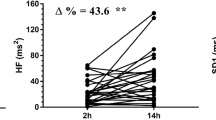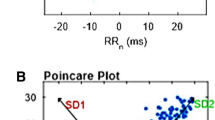Abstract
Purpose
Heart rate variability (HRV) has been a relevant tool in the assessment of the autonomic nervous system (ANS). How autonomic control normally develops in newborns and how it is affected by gestational age (GA) is not fully understood. We aimed to review the current evidence on HRV in preterm (PT) and term neonates (TN) and investigate the relation between GA and the maturation of ANS.
Methods
Electronic databases (Pubmed, World of Science, and Scopus) were searched for studies from 1997 to 2017 examining HRV (time and frequency domain) in PT and TN who followed to the Task Force (1996) guidelines. Ten studies met our inclusion criteria and were analyzed.
Results
An increasing postnatal age was related to a significant rise of HRV parameters. Several significant differences were established between PT and TN (lower values on PTN), also found when PTN are evaluated at their theoretical term age. In general, there were no relevant results on LF/HF (low frequency/high frequency) ratio, as being an adequate marker of sympathovagal balance, but this was not a universal finding of this review. Frequency parameters that were more often used to evaluate newborns and HF showed the most relevant increase with GA.
Conclusions
HRV is an important tool to assess the maturation of ANS in newborns and there is a progressive increasing on cardiac parasympathetic activity, according to GA. HF appears as a relevant parameter in measurements of vagal maturation. HRV is higher in TN when compared with PTN and is more studied in newborns in terms of frequency domain. Standard recommendations in newborns remain to be fully defined.
Similar content being viewed by others
References
Task Force of the European Society of Cardiology and the North American Society of Pacing and Electrophysiology (1996). Heart Rate Variability. Standards of measurement, physiological interpretation and clinical use. Eur Heart J 17:354–381
Billman GE (2011) Heart rate variability—a historical perspective. Front Physiol 2:86
Reyes del Paso GA, Langewitz W, Mulder LJ, van Roon A, Duschek S (2013) The utility of low frequency heart rate variability as an index of sympathetic cardiac tone: a review with emphasis on a reanalysis of previous studies. Psychophysiology 50:477–487
Selig FA, Tonolli ER, Silva EV, Godoy MF (2011) Heart rate variability in preterm and term neonates. Arq Bras Cardiol 96:443–449
Finley JP, Nugent ST, Hellenbrand W (1987) Heart-rate variability in children. Spectral analysis of developmental changes between 5 and 24 years. Can J Physiol Pharmacol 65:2048–2052
Gagnon R, Campbell K, Hunse C, Patrick J (1987) Patterns of human fetal heart rate accelerations from 26 weeks to term. Am J Obstet Gynecol 157:743–748
Tucker J, McGuire W (2004) Epidemiology of preterm birth. BMJ 329:675–678
Cabal LA, Siassi B, Zanini B, Hodgman JE, Hon EE (1980) Factors affecting heart rate variability in preterm infants. Pediatrics 65:50–56
Clairambault J, Curzi-Dascalova L, Kauffmann F, Medigue C, Leffler C (1992) Heart rate variability in normal sleeping full-term and preterm neonates. Early Hum Dev 28:169–183
Verklan MT, Padhye NS (2004) Spectral analysis of heart rate variability: an emerging tool for assessing stability during transition to extrauterine life. J Obstet Gynecol Neonatal Nurs 33:256–265
Andriessen P, Oetomo SB, Peters C, Vermeulen B, Wijn PF, Blanco CE (2005) Baroreceptor reflex sensitivity in human neonates: the effect of postmenstrual age. J Physiol 568:333–341
Fortrat JO (2002) Inaccurate normal values of heart rate variability spectral analysis in newborn infants. Am J Cardiol 90:346
Rosenstock EG, Cassuto Y, Zmora E (1999) Heart rate variability in the neonate and infant: analytical methods, physiological and clinical observations. Acta Paediatr 88:477–482
Longin E, Schaible T, Lenz T, Konig S (2005) Short term heart rate variability in healthy neonates: normative data and physiological observations. Early Hum Dev 81:663–671
Rassi D, Mishin A, Zhuravlev YE, Matthes J (2005) Time domain correlation analysis of heart rate variability in preterm neonates. Early Hum Dev 81:341–350
Nakamura T, Horio H, Miyashita S, Chiba Y, Sato S (2005) Identification of development and autonomic nerve activity from heart rate variability in preterm infants. Biosystems 79:117–124
Lucchini M, Fifer WP, Sahni R, Signorini MG (2016) Novel heart rate parameters for the assessment of autonomic nervous system function in premature infants. Physiol Meas 37:1436–1446
Longin E, Gerstner T, Schaible T, Lenz T, Konig S (2006) Maturation of the autonomic nervous system: differences in heart rate variability in premature vs. term infants. J Perinat Med 34:303–308
Patural H, Barthelemy JC, Pichot V, Mazzocchi C, Teyssier G, Damon G, Roche F (2004) Birth prematurity determines prolonged autonomic nervous system immaturity. Clin Auton Res 14:391–395
De Rogalski LI, Roche F, Pichot V, Teyssier G, Gaspoz JM, Barthelemy JC, Patural H (2007) Autonomic nervous system activity in premature and full-term infants from theoretical term to 7 years. Auton Neurosci 136:105–109
Patural H, Pichot V, Jaziri F, Teyssier G, Gaspoz JM, Roche F, Barthelemy JC (2008) Autonomic cardiac control of very preterm newborns: a prolonged dysfunction. Early Hum Dev 84:681–687
Krueger C, van Oostrom JH, Shuster J (2010) A longitudinal description of heart rate variability in 28–34-week-old preterm infants. Biol Res Nurs 11:261–268
Friedman WF (1972) The intrinsic physiologic properties of the developing heart. Prog Cardiovasc Dis 15:87–111
Eiselt M, Curzi-Dascalova L, Clairambault J, Kauffmann F, Medigue C, Peirano P (1993) Heart-rate variability in low-risk prematurely born infants reaching normal term: a comparison with full-term newborns. Early Hum Dev 32:183–195
Vanravenswaaijarts C, Hopman J, Kollee L, Stoelinga G, Vangeijn H (1994) Spectral-analysis of heart-rate-variability in spontaneously breathing very preterm infants. Acta Paediatr 83:473–480
Patzak A, Lipke K, Orlow W, Mrowka R, Stauss H, Windt E, Persson PB, Schubert E (1996) Development of heart rate power spectra reveals neonatal peculiarities of cardiorespiratory control. Am J Phys 271:R1025–R1032
Chatow U, Davidson S, Reichman BL, Akselrod S (1995) Development and maturation of the autonomic nervous system in premature and full-term infants using spectral analysis of heart rate fluctuations. Pediatr Res 37:294–302
Mazursky JE, Birkett CL, Bedell KA, Ben-Haim SA, Segar JL (1998) Development of baroreflex influences on heart rate variability in preterm infants. Early Hum Dev 53:37–52
Billman GE (2013) The LF/HF ratio does not accurately measure cardiac sympatho-vagal balance. Front Physiol 4:26
Author information
Authors and Affiliations
Corresponding author
Ethics declarations
Conflicts of interests
On behalf of all authors, the corresponding author states that there is no conflict of interest.
Appendix
Appendix
Rights and permissions
About this article
Cite this article
Cardoso, S., Silva, M.J. & Guimarães, H. Autonomic nervous system in newborns: a review based on heart rate variability. Childs Nerv Syst 33, 1053–1063 (2017). https://doi.org/10.1007/s00381-017-3436-8
Received:
Accepted:
Published:
Issue Date:
DOI: https://doi.org/10.1007/s00381-017-3436-8




